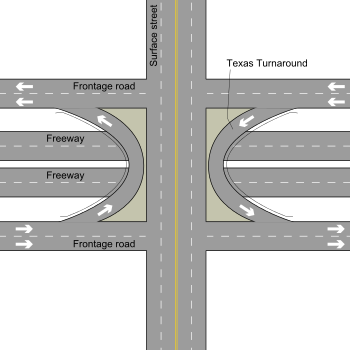Texas U-turn

A Texas U-turn, or Texas turnaround, boomerang, or loop around,[citation needed] is a lane allowing cars traveling on one side of a one-way frontage road to U-turn onto the opposite frontage road (typically crossing over or under a freeway or expressway). Typically controlled by yield signs, these allow U-turning traffic to bypass two traffic signals and avoid crossing the local traffic twice.
If the limited-access highway passes over the local road, the bridge (or bridges) must be longer, to span four directions of traffic and two sidewalks below. If the local road passes over the limited-access highway, the bridge must be wider, to carry four directions of traffic and two sidewalks over the highway.
Usage[]
This highway configuration originated (and is particularly common) in the U.S. state of Texas,[1] especially in the Austin, Dallas–Fort Worth, El Paso, Houston, and San Antonio metropolitan areas, but can also be found in Huntsville, Alabama; Peoria, Arizona;[2] Little Rock and North Little Rock, Arkansas; Clearwater, Fort Lauderdale and Jacksonville, Florida; Atlanta, Georgia; Chicago, Illinois; Wichita, Kansas; Detroit, Michigan; Jackson, Mississippi; Kansas City and St. Louis, Missouri; Las Cruces, New Mexico; New York City, New York; Cleveland, Ohio; Oklahoma City and Tulsa, Oklahoma; Lancaster, Pennsylvania; and Lehi and Provo, Utah.
It is common in Michigan[citation needed], where frontage roads travel along freeways. In some cases these are controlled by signals, and are similar to the Michigan left. They are also used less frequently in other areas of the world.
An unusual example of this configuration in the northeastern United States can be found at the Latham Circle, located in the hamlet of Latham, New York. Here, US Route 9 travels north-south underneath a roundabout carrying NY Route 2 east-west. In this case, the frontage roads are really the ramps which allow traffic from US Route 9 to connect to NY Route 2. These ramps are connected to two Texas U-turn ramps, which let motorists exiting adjacent businesses to travel in the opposite direction, and onto US Route 9.
Another example of this is in the Bronx, New York City at Rosedale Avenue by the Cross Bronx Expressway (I-95) at exit 4B for motorists heading north on the Cross Bronx to turn and head back south or to connect to the northbound Bronx River Parkway without disturbing Rosedale Avenue. This is due to the nearby I-895 and East 177th Street not having direct connections to the Bronx River Parkway, which is also nearby.[3]
In Queens, New York City, there is a Texas U-turn at I-678 near northbound exit 14 (Linden Place). This is so motorists can get to the nearby shopping center located to the west of I-678.
In Lynnfield, Massachusetts, a northeast suburb of Boston, the Northeast Expressway (Route 1) has a frontage road carrying traffic bound for Route 129. At the intersection of the frontage road and Route 129, a Texas U-turn allows for traffic to access the opposite side of Route 1.
In California, Texas U-turns can be found along these four sections of highways:
- In Santa Ana, a Texas U-turn is used for northbound Interstate 5 traffic exiting onto First Street via Mabury Street.[4]
- In downtown Los Angeles, Interstate 10 (Santa Monica Freeway) has a Texas U-turn along East 17th Street (serving as an eastbound frontage road). Exiting eastbound traffic can u-turn under the freeway to access San Pedro Street before Griffith Avenue.[5]
- In Bakersfield, California State Route 178 has a Texas U-turn along Niles Street (serving as a westbound frontage road) for the freeway. Westbound traffic can u-turn under the freeway at Union Avenue to transition onto the eastbound frontage road, Monterey Street.[6]
- On Terminal Island in Long Beach, a Texas U-turn is used for traffic on westbound Ocean Boulevard (before the Terminal Island Freeway, SR 47) wanting to access the eastbound Gerald Desmond Bridge (northbound I-710). The new Texas U-turn (which opened in July 2019) is part of the project to replace the Gerald Desmond Bridge.[7][8]
In Edmonton, Alberta, examples can be found along the Yellowhead Trail.
In London, United Kingdom, examples can be found beneath the Hammersmith flyover and also at the Hanger Lane gyratory.
In Birmingham, United Kingdom, an example can be found on the Queensway outside St. Chad's Cathedral.
In Sydney, Australia, Texas U-turns are located at the junction between the Pacific Highway and the A3 (Ryde Road & Mona Vale Road).
In Nanjing, China, Texas U-turns are common along the Inner Ring Road.
In Saudi Arabia Texas U-turns are common throughout the entire Saudi highway system, especially in Riyadh.
In Doha, Qatar, several Texas U-turns are found on the Salwa Highway and in Al Rayyan on Al Rayyan Al Jadeed Street.
In Manama, Bahrain, Texas U-turns are found along Shaikh Isa bin Salman highway.
In Kuwait City, Kuwait Texas U-turns are common.
In Muscat, Oman, two Texas U-Turns are located on Sultan Qaboos St in Al-Badi.
See also[]
 U.S. Roads portal
U.S. Roads portal- Overpass
- Turnaround (road)
References[]
- ^ Section 2.1
- ^ [1]
- ^ Bronx River Parkway 40°50′10″N 73°52′13″W / 40.8360°N 73.8702°W – map
- ^ Exit 103C from northbound I-5 in Santa Ana, CA Google Maps. Retrieved 30 August 2020.
- ^ 941 E 17th St - Los Angeles, California Google Street View. April 2019. Retrieved 30 August 2020.
- ^ 38 Niles St - Bakersfield, California Google Street View. May 2019. Retrieved 30 August 2020.
- ^ First ‘Texas U-Turn’ in California Opens Tomorrow Gerald Desmond Bridge Replacement Project. Retrieved 30 August 2020
- ^ California’s first ‘Texas U-turn’ set to open this weekend as part of the Gerald Desmond Bridge Replacement Project Long Beach Press-Telegram. 17 July 2019. Retrieved 30 August 2020.
External links[]
- A Texas U-turn in Google Maps Street View; another one, viewed from the freeway
- Texas Highwayman's Primer on Texas Highways has a diagram of Texas U-turn.
- Road infrastructure
- Road junction types
